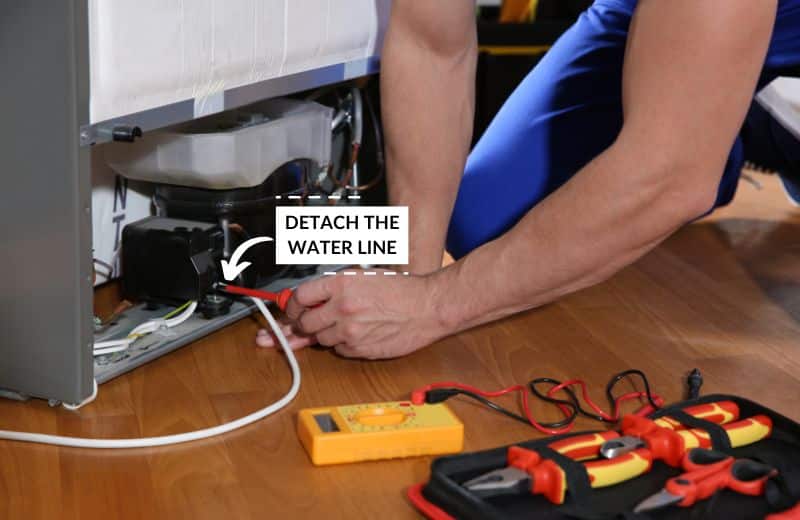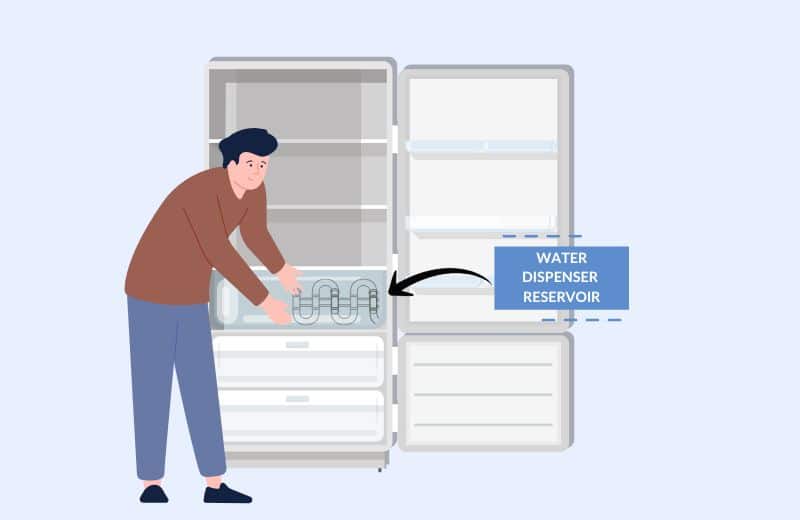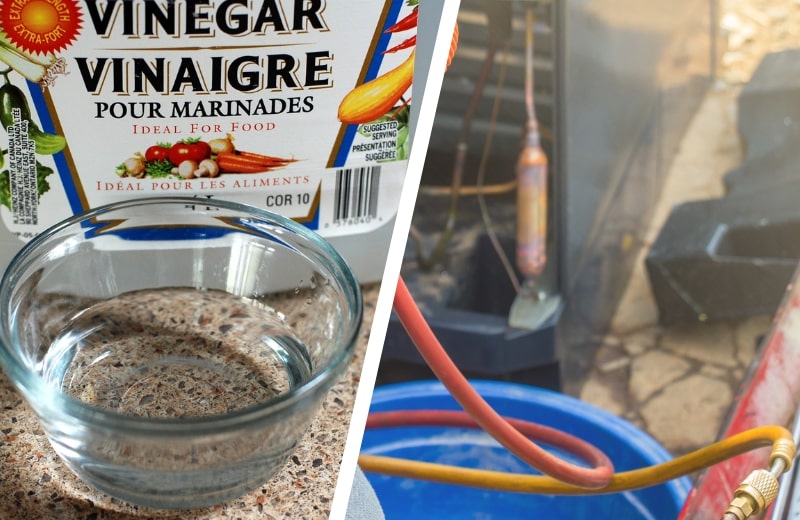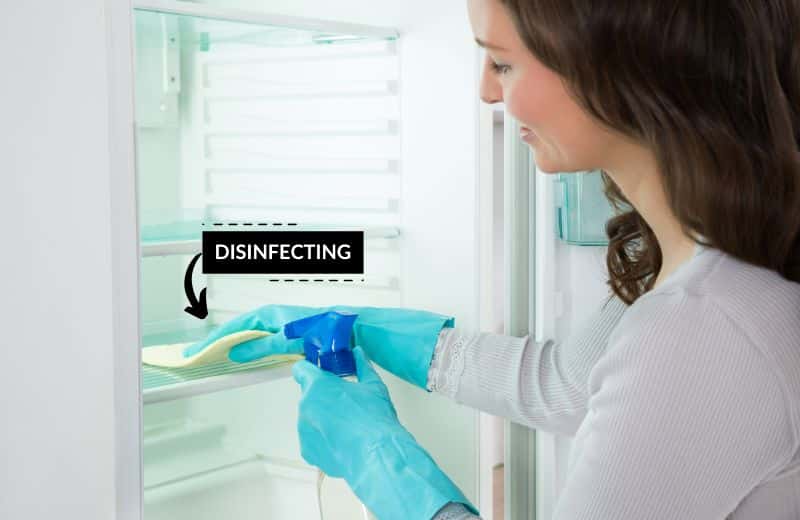When was the last time you cleaned your refrigerator’s water lines? If you can’t remember – or you’ve never cleaned them – you’ve come to the right place.
Here, we’ve outlined the simple steps involved in cleaning your refrigerator water line.
📌 Key Takeaways:
- You should clean your fridge water dispenser and ice maker line to ensure ice or water from the refrigerator is safe to drink.
- To clean fridge water lines, you need a clean cloth, an empty bowl, distilled white vinegar, a small wrench, a screwdriver, clamps, and a funnel.
- Aim to clean your refrigerator’s water lines every two months, or at least when you replace the fridge water filter.
Table of Contents
🧽 How To Clean A Refrigerator Water Line: Step By Step
Find the step-by-step cleaning process for a refrigerator water line below.
Step 1: Gather Your Supplies
First, gather the supplies you need for cleaning.
You will need:
- Clamps
- Small wrench
- Screwdriver
- 3-6 cups distilled white vinegar solution
- Clean cloth or rag
- Medium-sized bowl or bucket
Step 2: Shut Off & Unplug Your Fridge
When you have your supplies, shut off the water supply to your fridge. You can usually do this by locating and turning the valve behind your fridge or underneath your kitchen sink.
If you don’t have a valve in this location, you might need to switch off the main water supply valve in your home. This can usually be found in a basement, garage, cupboard, or wherever the main water line enters your home.
Once the water is shut off, unplug the fridge from the power outlet to cut off the electricity supply.

Step 3: Detach The Water Line
Next, pull the refrigerator away from the wall as much as it will allow, then remove the lower portion of the back of the fridge and detach the water line from the rest of the fridge. Place a clean cloth on the floor to catch any leaks.
You’ll need to use a screwdriver for this, and you might also need a wrench, depending on your refrigerator design. Check your user manual if you’re unsure.

Step 4: Clean The Water Dispenser Reservoir
Now is also a good time to clean your water dispenser reservoir.
This is typically located behind the crisper draw. Carefully remove the reservoir and drain the water, then fill it with distilled vinegar (a good ratio is 1 cup per 1 gallon of water) and run it through the system.
Once you’ve finished, run clean water into the reservoir and continue dispensing until your water no longer tastes like vinegar.
Our tip: You can add a couple of tablespoons of baking soda to the vinegar solution to boost its cleaning power.

Step 5: Flush The Water Dispenser Lines
You can now move on to cleaning the dispenser and ice maker line.
Pour vinegar into the line using a funnel to direct the flow. Leave the vinegar to sit for about 10 minutes, clamping the line with a small clamp to stop the vinegar from leaking out.
Step 6: Drain The Lines
After letting the vinegar sit for long enough, drain it from the lines.
Drain the water dispenser line by dispensing the vinegar into a bucket or bowl. Then flush the line with clean water to remove all the vinegar from the system.
Drain the ice maker line by sending the vinegar back out of the line, then send clean water through the line at least three times before you reattach it to the fridge.

Step 7: Reconnect The Lines
Finally, connect the lines back up to your fridge and replace the parts that you removed. Push the fridge back against the wall, plug it in, and turn the water supply valve to send water back into the fridge.
Program your refrigerator to make a batch of ice, then discard this batch in your sink. Once you’ve done this, remove the ice tray and thoroughly wash it in soapy water at your kitchen sink. Dry it with a cloth or paper towel, then return it to your refrigerator.
Next, open the water dispenser and dispense around 5 gallons of water into a bucket or bowl. This should remove lingering or excess vinegar.
Taste your water. It should now taste clear and clean.
🪛 How To Clear Clogged Lines In A Refrigerator
If your refrigerator water supply line is clogged, you might need to take a few extra steps to fix the issue.
After unplugging your fridge and pulling it away from the wall, look carefully at the water or ice line and check for folds, kinks, or sediment blockages.
The most likely cause of a blockage in the line is a piece of ice. Wait a few minutes to see if the ice will melt and liquefy on its own. If you have ice throughout the line, you might need to defrost the freezer.
An alternative is to use a straw brush to clean out the inside of the line with a warm water and soap mixture.
A straw brush is a small, thin brush that’s designed to clean out the inside of reusable straws – and it also does a great job of cleaning fridge water lines. Simply dip the brush in a solution of warm water and grease-fighting dish soap, then work the brush back and forth inside the line to clear the blockage.
Related Article: Why is my fridge water dispenser slow?
📅 How Often Should You Clean Your Refrigerator Water Line?
You should aim to clean your fridge water line once every 2 months. This cleaning frequency should prevent contaminants from being able to accumulate in your ice and water systems and keep the end products clean and safe to drink.
Try to make this job a scheduled part of your refrigerator’s routine maintenance. At the very least, you should flush and clean your refrigerator’s water lines every 6 months, when you replace the water filter.

🔎 What Happens If You Don’t Clean Your Refrigerator Water Lines?
Cleaning the water lines in your ice maker and fridge dispenser system ensures that your refrigerator’s water and ice are free from bacteria, mold, and other contaminants that might make them unsafe for human consumption.
If you don’t clean your refrigerator water line, you’ll allow for mineral buildup and microorganism accumulation in the line, especially if the fridge has a water filter that hasn’t been replaced when it should have been.
The water system in your fridge is damp, which may encourage mold growth if it isn’t properly maintained. If you have hard water, excess minerals will also build up in your refrigerator lines, forming limescale and restricting water flow.
In short, without regular cleaning, your fridge’s water and ice production may be hindered – and, in a worst-case scenario, you’ll risk making yourself sick by drinking water contaminated with bacteria or mold.
Continue Reading:
- Are Refrigerator Water Filters Worth the Investment? The Truth Revealed
- Step-by-Step Guide: Connecting a Reverse Osmosis System to Your Refrigerator
- Expert-Recommended: The 10 Best Refrigerator Water Filters of 2024
📑 Final Word
Cleaning your refrigerator water line is an important step towards maintaining a hygienic ice maker and water dispenser system. But don’t stop there.
If your fridge has a water filter, it’s essential that you replace the filter as recommended by the manufacturer (usually once every 6 months).
Leaving a dirty water filter in your fridge is likely to cause buildup and clogging in your water lines because the filter is no longer able to remove certain contaminants from your water supply – and because an old filter may harbor bacteria that could spread and travel into your dispenser reservoir and ice machine.
👨🔧 Learn more about how often you should replace your refrigerator’s water filter and when to know when your filter has reached the end of its lifespan in our fridge filter replacement guide.
